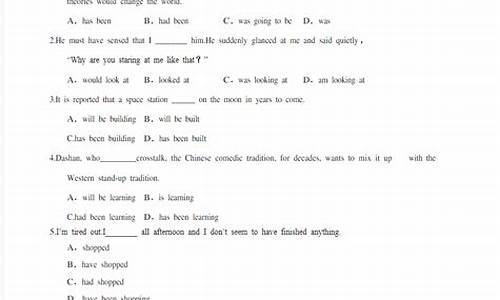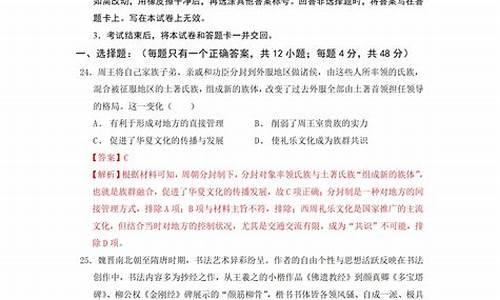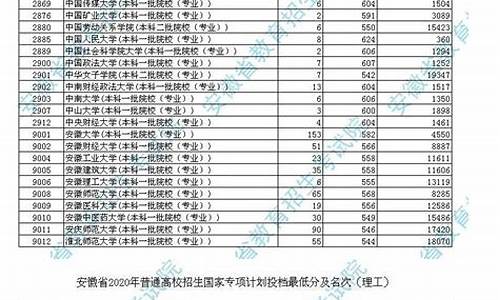您现在的位置是: 首页 > 教育资讯 教育资讯
高考英语时态语态陷阱题汇编_英语高考语态
tamoadmin 2024-05-15 人已围观
简介1.英语几种语态?都是什么?都是怎么构成的? 动词的语态是动词的一种形式,表示主语和谓语之间语法或语义的关系,许多同学都掌握得不好。让我们一起学习吧!以下我为大家编辑的动词的语态英语基础语法知识点汇总,欢迎大家阅读! 1 动词的语态 语态有两种:主动语态和被动语态。 主语是动作的发出者为主动语态;主语是动作的接受者为被动语态。 1)若宾语补足语是不带to 的不定式,变为被动语态 时,该
1.英语几种语态?都是什么?都是怎么构成的?

动词的语态是动词的一种形式,表示主语和谓语之间语法或语义的关系,许多同学都掌握得不好。让我们一起学习吧!以下我为大家编辑的动词的语态英语基础语法知识点汇总,欢迎大家阅读!
1 动词的语态
语态有两种:主动语态和被动语态。
主语是动作的发出者为主动语态;主语是动作的接受者为被动语态。
1)若宾语补足语是不带to 的不定式,变为被动语态 时,该不定式前要加"to"。此类动词为感官动词。
feel, hear, help, listen to, look at, make, observe, see, notice, watch
The teacher made me go out of the classroom.
--> I was made to go out of the classroom (by the teacher).
We saw him play football on the playground.
--> He was seen to play football on the playground.
2)情态动词+ be +过去分词,构成被动语态。
Coal can be used to produce electricity for agriculture and industry.
琴声悠悠550字1 let 的用法
1)当let后只有一个单音节动词,变被动语态时,可用不带to 的不定式。
They let the strange go.---> The strange was let go.
2) 若let 后宾补较长时,let 通常不用被动语态,而用allow或permit 代替。
The nurse let me go to see my classmate in the hospital.
----> I was allowed / permitted to see my classmate in the hospital.
2 短语 动词的被动语态
短语动词是一个整体,不可丢掉后面的介词或副词。
This is a photo of the power station that has been set up in my hometown.
My sister will be taken care of by Grandma.
Such a thing has never been heard of before..
3 表示"据说"或"相信" 的词组
believe, consider, declare, expect, feel , report, say, see, suppose, think, understand
It is said that… 据说
It is reported that… 据报道
It is believed that… 大家相信
It is hoped that… 大家希望
It is well known that… 众所周知
It is thought that… 大家认为
It is suggested that… 据建议
It is taken granted that… 被视为当然
It has been decided that… 大家决定
It must be remember that…务必记住的是
It is said that she will leave for Wuhan on Tuesday.
4不用被动语态的情况
1) 不及物动词或动词短语无被动语态:
appear, die disappear, end (vi. 结束), fail, happen, last, lie, remain, sit, spread, stand
break out, come true, fall asleep, keep silence, lose heart, take place.
After the fire, very little remained of my house.
比较: rise, fall, happen是不及物动词;raise, seat是及物动词。
(错) The price has been risen.
(对) The price has risen.
(错) The accident was happened last week.
(对) The accident happened last week.
(错) The price has raised.
(对) The price has been raised.
(错) Please seat.
(对) Please be seated.
要想正确地使用被动语态,就须注意哪些动词是及物的,哪些是不及物的。特别是一词多义的动词往往有两种用法。解决这一问题唯有在学习过程中多留意积累。
2) 不能用于被动语态的及物动词或动词短语:
fit, have, hold, marry, own, wish, cost, notice, watch agree with, arrive at / in, shake hands with, succeed in, suffer from, happen to, take part in, walk into, belong to
This key just fits the lock.
Your story agrees with what had already been heard.
3) 系动词无被动语态:
appear, be become, fall, feel, get, grow, keep, look, remain, seem, smell, sound, stay, taste, turn
It sounds good.
4) 带同源宾语的及物动词,反身代词,相互代词,不能用于被动语态:
die, death, dream, live, life
She dreamed a bad dream last night.
5) 当宾语是不定式时,很少用于被动语态。
(对) She likes to swim.
(错) To swim is liked by her.
5 主动形式表示被动意义
1)wash, clean, cook, iron, look, cut, sell, read, wear, feel, draw, write, sell, drive…
The book sells well. 这本书销路好。
This knife cuts easily. 这刀子很好用。
2)blame, let(出租), remain, keep, rent, build
I was to blame for the accident.
Much work remains.
3) 在need, require, want, worth (形容词), deserve后的动名词必须用主动形式。
The door needs repairing.= The door needs to be repaired.
This room needs cleaning. 这房间应该打扫一下。
This book is worth reading. 这本书值得一读。
4) 特殊结构:make sb. heard / understood (使别人能听见/理解自己),have sth. done ( 要某人做某事)。
6 被动形式表示主动意义
be determined, be pleased, be graduated (from), be finished, be prepared (for), be occupied (in), get marries
He is graduated from a famous university.
他 毕业 于一所有名的大学。
注意: 表示同某人结婚,用marry sb. 或get married to sb. 都可。
He married a rich girl.
He got married to a rich girl.
7 need/want/require/worth
注意:当 need, want, require, worth(形容词)后面接doing也可以表示被动。
Your hair wants cutting. 你的头发该理了。
The floor requires washing. 地板需要冲洗。
The book is worth reading. 这本书值得一读。
典型例题
The library needs___, but it'll have to wait until Sunday.
A. cleaning B. be cleaned C. clean D. being cleaned
答案A. need (实意) +n /to do,need (情态)+ do,当为被动语态时,还可need + doing. 本题考最后一种用法,选A。如有to be clean 则也为正确答案。
典:done,"不可能已经"。must not do 不可以(用于一般现在时)。
动词的语态英语基础语法知识点汇总相关 文章 :
1. 高考英语动词的时态和语态语法知识点与技巧方法
2. 英语语法:动词的时态和语态
3. 英语基础语法知识点汇总:动词的语态
4. 动词的语态语法讲解及练习题
5. 动词英语基础语法
6. 初中常考的英语语法知识点汇总
7. 英语动词的语法归纳
8. 最新九年级英语语法知识点总结大全
9. 九年级英语语法知识点整理归纳
10. 英语被动语态知识点总结讲解
英语几种语态?都是什么?都是怎么构成的?
高考英语语法知识点
一般过去时
①一般过去时的基本用法:表示过去的事情、动作或状态常与表示过去具体的时间状语连用(或有上下文语境暗示);用于表达过去的习惯;表示说话人原来没有料到、想到或希望的事通常用过去式。如:
I met her in the street yesterday.
I once saw the famous star here.
They never drank wine.
I thought the film would be interesting,but it isn’t.
②如果从句中有一个过去的时间状语,尽管从句中的动作先于主句发生,但从句中的谓语动词连用过去式。如:
③表示两个紧接着发生的动作,常由以下词语连接,用一般过去时。如:but, and, when, as soon as, immediately, the moment, the minute。
The moment she came in, she told me what had happened to her.
He bought a watch but lost it.
④常用一般过去时的句型:
Why didn’t you / I think of that?
I didn’t notice it.
I forgot to tell you I had been there with my brother before.
I didn’t recognize him.
高考英语知识要点
1.表示“大量、许多”
可数:number/many/dozen/a great number 不可数:a great deal/amount/much 都可以:plenty of/lot/quantity/mass
2.可以修饰形容词比较级:far/even/any/much/rather/a bit/a lot
3.lie躺-lay-lain-lying 撒谎-lied-lied-lying
Lay下蛋-laid-laid-laying
4.can表示能力,be able to表示经过努力,有时态变化
5.receive强调客观接收,accept强调主观接受
6.on account of因为,由于;account for说明原因解释
7.accuse sb of指控某人,sue指控
8.add to增加扩大,add up加起来,add up to总共总计
9.afford负担得起,抽得出时间
10.after以过去为起点,用于过去时态,in以将来为起点,用于将来时态
英语共有十六个时态、四个体。(注:四个体为——一般、进行、完成、完成进行。)
英语中的四个体相当于法语、西班牙语以及所有印欧语系罗曼语族中的式,如:直陈式,命令式等。
(1)一般现在时
基本形式(以do为例):
主动态:do;
被动态:doing、be done;
过去时:did;
第三人称单数:does(主语为非第三人称单数);
肯定句:主语+动词原形+其他;
否定句:主语+don‘t+动词原形+其他;
一般疑问句:Do+主语+动词原形+其他。
肯定回答:Yes,+ 主语+do.
否定回答:No,+主语+don't.
特殊疑问句:疑问词+一般疑问句语序
(2)一般过去时
be动词+行为动词的过去式
was/were+not;在行为动词前加didn‘t,同时还原行为动词
was或were放于句首;用助动词do的过去式did提问,同时还原行为动词
(3)一般将来时
am/are/is+going to+do
will/shall+do
am/is/are/about to + do
am/is/are to + do
一般将来时的表达方法
be going to +动词原形
be +不定式,be to+动词原形,be about to +动词原形
be able to +不定式
be about to+动词原形
(4)过去将来时
be(was,were)going to+动词原形
be(was,were)about to+动词原形
be(was,were)to+动词原形
肯定句:主语+be(was,were)going to+动词原形~.
否定句:主语+be(was,were)not going to+动词原形~.
疑问句:Be(Was,Were)+主语+going to+动词原形~?
肯定句:主语+would(should)+动词原形~.
否定句:主语+would(should)not+动词原形~.
疑问句:Would(Should)+主语+动词原形~?
(5)现在进行时
主语+be+动词ing〔现在分词〕形式
第一人称+am+doing+sth
第二人称+are+doing +sth
第三人称+is+doing+sth
(6)过去进行时
肯定句:主语+was/were+doing+其它
否定句:主语+was/were+not+doing+其它
一般疑问句及答语:Was/Were+主语+doing+其它 答语:Yes,I was./No,I wasn't.
特殊疑问句:特殊疑问词+was/were+主语+doing+其它
(7)将来进行时
动词be的将来时+现在分词
(8)现在完成时
基本结构:主语+have/has+过去分词(done)
①肯定句:主语+have/has+过去分词+其他
②否定句:主语+have/has+not+过去分词+其他
③一般疑问句:Have/Has+主语+过去分词+其他
④特殊疑问句:特殊疑问词+一般疑问句(have/has+主语+过去分词+其他
(9)过去完成时
基本结构:主语+had+过去分词(done)
①肯定句:主语+had+过去分词+其他
②否定句:主语+had+not+过去分词+其他
③一般疑问句:Had+主语+过去分词+其他
肯定回答:Yes,主语+had
否定回答:No,主语+hadn't
④特殊疑问句:特殊疑问词+一般疑问句(had+主语+过去分词+其他)
语法判定:
( 1 ) by + 过去的时间点。如:
I had finished reading the novel by nine o'clock last night.
( 2 ) by the end of + 过去的时间点。如:
We had learnt over two thousand English words by the end of last term.
( 3 ) before + 过去的时间点。如:
They had planted six hundred trees before last Wednesday.
(10)将来完成时
(shall)will+have+动词过去分词
before+将来时间或by+将来时间
before或by the time引导的现在时的从句
(11)现在完成进行时
have/has been +-ing 分词
(12)过去完成进行时
had been +-ing 分词
(13)将来完成进行时
主语+ shall/will have been doing
(14)过去将来进行时
should(would)+be+现在分词
(15)过去将来完成时
should / would have done sth.
(16)过去将来完成进行时
should+have been+现在分词用于第一人称
would have been+现在分词用于其他人称
举例:
英语中有12个主要时态,都来自于三时(过去、现在、将来)
现在以I listen为例,举例英语中有12个主要时态如下所示:
一般现在时:I listen
现在进行时:I am listening
过去进行时:I was listening
现在完成时:I have listened
现在完成进行时:I have been listening
一般将来时:I shall listen”或“I will listen.”
将来进行时:I shall be listening
一般过去时:I listened
过去完成时:I had listened
过去完成进行时:I had been listening
将来完成时: I shall have listened
将来完成进行时: I shall have been listening
英语中不存在属格
一个普遍的误解是在英语中只存在一个以“'s”结尾表示所属的属格。然而,语言学家已经表明英语的所有格完全不是一个格,而是一个独立的词并且在书写和发音上都不是前一个词的一部分,这可以有下面这个句子表明:The King of Sparta's wife was called Helen.(斯巴达国王的妻子叫做海伦。)如果“'s”是属格,那么“妻子”(wife)就属于“斯巴达”(Sparta),但是“'s”并不是只表示“斯巴达”(Sparta),而是表示“斯巴达国王”(King of Sparta)。
上面这个例子并不表明英语没有自己的属格;但是它现在已经发展成为另一个形式。在古英语中,ban的属格形式是banes。后来在现代英语中,这个发展成为了使用“'s”表示的“bone's”。在18世纪,人们对此的解释是省略号代替了一个属格代词,就像“the King's horse”是“the King, his horse”的缩写。但是这个解释是不正确的。人们更相信是省略号代替了古英语中的“e”。
英语和“与格”
在现代英语中,与格不再是英语语法的一部分,它只出现在一些表达用语中。一个很好的例子是单词methinks(据我看来)。它来源于古英语的与格形式变化:me(与格的人称代词)+thinks(to seem,与动词词组to think很接近的一个词组)。 与格在英语中可以不要前置词,例如在“He built me a snowman.”中一样。在这个例子中,“me”是与格。









